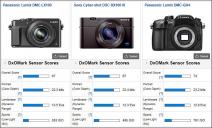
-
Comparing Standard and Natural Color Profiles:
Each scene shot sequentially in Standard and Natural Mode. A variety of high-contrast bright outdoors shots and high-contrast indoors shots in dim light.This video contains only the Natural mode shots:
-

 z_inside19.jpg800 x 609 - 43K
z_inside19.jpg800 x 609 - 43K -
Does anybody here know if the GX7 and LX100 take the same batteries? I found this battery that looks like it may work, it certainly looks the same, but I'm not 100% sure.
http://www.amazon.com/gp/product/B00EEA960W/ref=ox_sc_act_title_3?ie=UTF8&psc=1&smid=AOO5G0FMW2BC9
-
Yes I have those batteries and they work on my lx100. Battery indicator is inconsistent though.
-
Great, thanks mpgxsvcd. I'll order some. Normally I buy Wasabi products, but the Wasabi batteries for the GX7 et al. is only 1100mah, vs the 1400 mah of the Halcyon.
-
The LX100 is a revolutionary camera and not just because it features such a great new 24-75mm F1.7-F2.8 lens, a relatively large sensor, and excellent 4K video quality. It is revolutionary because of its new Aperture and Shutter Speed control dials and its excellent Auto ISO functionality.
I produced a video review below that includes some tips and tricks for getting the most out of the camera.
The tendency for most experienced users is to rely completely on the manual modes instead of using the fully automated Program Priority mode with Auto ISO. With previous cameras that was almost always the best decision because those cameras required several clicks of one or more control wheels in order to switch from one P.A.S.M mode to another.
It may not sound like much but switching the P.A.S.M mode dial and then changing to a different dial to adjust your Aperture and Shutter speed adds extra time for those spur of the moment images and videos.
Therefore most users would just place the camera in full manual mode right from the start. They would never even bother with the fully automated Program Priority mode with Auto ISO because it rarely would choose what they want.
Program Priority mode with Auto ISO often chose too fast or too slow of a shutter speed. In addition it wouldn’t stop down the aperture enough or it would stop it down too much for the scene at hand. Most of that is not an issue anymore with the LX100.
Panasonic has tweaked their Auto ISO and Intelligent ISO logic just enough with the LX100 so that it now selects the optimum settings for the majority of scenes that you will encounter. If you want slow shutter speeds it can select that in low light. If you want fast shutter speeds when there is subject movement it can do that as well. Also if you want the optimum aperture for detail and you want everything in focus it will do that.
Now it isn’t perfect. It can’t read your mind and determine what “you” think is best. However, the best thing about the LX100 is that it has those terrific direct Aperture and Shutter speed dials. Now with the improved logic of the LX100’s Auto ISO mode you can get a good idea of what the camera thinks are the appropriate settings and then quickly adjust the settings that you don’t agree with. No more fiddling with multiple control dials just to change the shutter speed or aperture. One quick dial turn can instantly select the shutter speed or aperture you think is best.
In the past a lot of Pro photographers had trouble switching from full frame sensor cameras to smaller compact cameras because they weren’t accustomed to the much broader depth of field with smaller sensors. They usually stopped down way too much thinking that their depth of field would be too shallow at F2.8 and below.
Now with the LX100’s outstanding Program Priority logic with Auto ISO those users can get a good idea of what Panasonic thinks is an appropriate Aperture and Shutter speed for a certain situation. You still have all of the freedoms that you had before to select other settings. However, now you actually have good sound logic in the auto modes whereas before the cameras would pick apertures and shutter speeds that simply didn’t make sense at all for any situation.
You really have to give Program Priority mode a try to understand what is better about it. You also have to put aside your experiences from larger sensor cameras for a moment because they don’t always apply to smaller sensor cameras.
The depth of field will always be much broader even wide open with the smaller sensor camera. In addition the lenses usually have more detail even in the corners when they are closer to wide open than they do stopped down past F8.0.
I hope everyone gives Program Priority with Auto or Intelligent ISO a try with this camera. I am not suggesting that you should only use this mode. I am suggesting that you should always start with this mode and then ask yourself “Do I really know more about this scene than the camera does”? Is stopping the lens down actually giving me more depth of field or is everything in focus already. Stopping down further might actually be decreasing the detail in my image.
Is it really worth using a very slow shutter speed here or is it better to just shoot at a slightly higher ISO value and not risk blur due to subject motion even if the excellent image stabilization can take care of the camera shake.
I have finally found a camera that I can take everywhere with me and instantly pull it out and get a great shot right away even in Auto modes. I can also hand the camera off to anyone else and not have to worry about whether they are going to select the correct settings or not.
We spend so much time berating the “Point and Shoot” camera style. However, there are plenty of times when that is exactly what we wish we had. There is a time and a place for manual modes and other instances where full Auto is actually the most efficient option. The LX100 gives us the best of both of those worlds.
-

 z_various1.jpg677 x 450 - 88K
z_various1.jpg677 x 450 - 88K -
"I produced a video review below that includes some tips and tricks for getting the most out of the camera."
Brilliant video Mark, especially for someone dragging their feet in buying the LX100, like yours truly :(
The one thing I haven't noticed in your review is tips on the max recording time at 4K. I saw a review (somewhere) which said some LX100s would record for an hour before the camera overheats and stops filming. What is your experience?
-
I haven't focused on video for the reviews yet. My first goal was to illustrate what has changed for Auto ISO. My primary focus was on stills. I need to do 1 or 2 more reviews on stills first then I will do the video side. I will test your question now though. I had just assumed it would fail after 15 minutes.
-
A selfish and shiftless try to realize a little dream
-
@utezet: That link is dead... typo?
-
Just tested the max recording time of video at 4K resolution: It was 15 minutes before it stopped and showed a message on the LCD screen: Recording has stopped because it has exceeded the time limit.
I have tried both the 24P and the 30P, and both behave identically: Over the 15 minutes it will produce three separate MP4 files, the first is 4GB in size which corresponds to about 6 minutes in length, the second the same, and the third about 2GB in size and about 3 minutes in length.
The good news is that when it stops, you can restart the recording immediately by pressing the red button again. It is clear that the time limit is NOT heat related. The camera was not even warm, by the way.
-
A few video oriented questions: Will the results of this camera be comparable to a let's say GH3/GH4 with the 12-35 f2.8 in terms of DOF, Noise at high iso, and stabilisation? How good or bad is the video at ISO 3200? And another question, does the 35mm @ 2.8 offer a decent amount of separation of the background for portraits? Does the 1080p 24p/60p have the EXTele option? I know I can crop the 4k if I need a bit more range out of the lens, but I'll be interested in knowing if that option is available if I would like to use it when conforming 60 to 24p in 1080. My ideal combo will be a GH4 with the 12-35 lens (specially for the 96fps) but after considering different options I'm considering more and more the LX100 option.
-
I noticed right away on the Leica version that the counter starts at 15:00 as soon as you start shooting video and then counts down, so no need to even test.
-
@vulgatron I own the LX100 and the GH4 with the 12-35 lens and I would say that the results are comparable at 35mm regarding DOF and Noise. Stabilisation is better at the LX100. 3200 ISO is still usable on both cameras, but represents the upper limit for my taste. I find both combinations usable for portraits, although I prefer the look of the range above 40mm (i.e. the 45/2.8 or 35-100/2.8 lens) on the GH4. The LX100 does not have the EXTele mode. Generally, I recommend to try both combinations by yourself before buying.
@markr041 I really like your Hong Kong Lake video. It shows the shallow DOF achievable with the LX100 and demonstrates the good OIS.
-
@sportster Thanks. I agree with your assessments. The OIS is noticeably better on the LX100 than on any of the Power OIS lenses I own for the GH4. I don't miss having more telephoto using the LX100 as much as I thought.
-
Hi Guys. This is what I own:
Hacked Panasonic GH2, 14-42mm original lens, 25mm + 35mm cheap CCTV lenses, 28mm 2.8 very cheap lens, 58mm 2.0 zenit helios lens.
I'm thinking to sell all of those and get the LX100. Do you think it is a good deal? A friend of mine is warning me about the differences on the cameras. What concerns me most is that when I look into LX100 footage I have the strange sensation that there is "too much detail", some weird effects on objects made of metal with many lines. And when the camera moves it looks strange
Can someone give me some advice and explain if the LX100 would be good for video (amateur indie documentary style).
Thanks and I'm sorry if I didn't use the right terms.
-

 came-8000-4.jpg800 x 597 - 111K
came-8000-4.jpg800 x 597 - 111K -

 came-8000-5.jpg737 x 445 - 72K
came-8000-5.jpg737 x 445 - 72K -
The LX100 seems better than Gh4 for Low Light ISO here :
-
The above reviewer has two main complaints, both of which reflect his ignorance of the camera's features.
Complaint 1: He keeps mistakenly activating the IA button. But, he does not know he can set that button to only invoke IA when pressed and held. This is specifically designed to prevent accidental IA.
Complaint 2: He says that you cannot pick a 1/50th shutter speed, because the top dial only has 1/60th. But he does not know that the front dial allows the choice of shutter speeds between the top dial settings. So, when the top dial is set at 1/60th, you can choose 1/50th, or 1/80th, etc. with the front dial.
He also complains about the "flatness" of 4K video. He clearly does not understand all the settings for video picture styles. That he normally shoots video using a Canon DSLR tells us he is very tolerant of (blind to?) low resolution and moire, and thus does not appreciate appropriately 4K on the LX100.
-
@markr041, Thanks for the tips. I must admit that I did not know these (IA button option and front dial for controlling shutter speeds) until reading your post.
Howdy, Stranger!
It looks like you're new here. If you want to get involved, click one of these buttons!
Categories
- Topics List23,964
- Blog5,723
- General and News1,342
- Hacks and Patches1,151
- ↳ Top Settings33
- ↳ Beginners254
- ↳ Archives402
- ↳ Hacks News and Development56
- Cameras2,361
- ↳ Panasonic990
- ↳ Canon118
- ↳ Sony154
- ↳ Nikon96
- ↳ Pentax and Samsung70
- ↳ Olympus and Fujifilm99
- ↳ Compacts and Camcorders299
- ↳ Smartphones for video97
- ↳ Pro Video Cameras191
- ↳ BlackMagic and other raw cameras121
- Skill1,961
- ↳ Business and distribution66
- ↳ Preparation, scripts and legal38
- ↳ Art149
- ↳ Import, Convert, Exporting291
- ↳ Editors191
- ↳ Effects and stunts115
- ↳ Color grading197
- ↳ Sound and Music280
- ↳ Lighting96
- ↳ Software and storage tips267
- Gear5,414
- ↳ Filters, Adapters, Matte boxes344
- ↳ Lenses1,579
- ↳ Follow focus and gears93
- ↳ Sound498
- ↳ Lighting gear314
- ↳ Camera movement230
- ↳ Gimbals and copters302
- ↳ Rigs and related stuff272
- ↳ Power solutions83
- ↳ Monitors and viewfinders339
- ↳ Tripods and fluid heads139
- ↳ Storage286
- ↳ Computers and studio gear560
- ↳ VR and 3D248
- Showcase1,859
- Marketplace2,834
- Offtopic1,319
Tags in Topic
- panasonic 576










